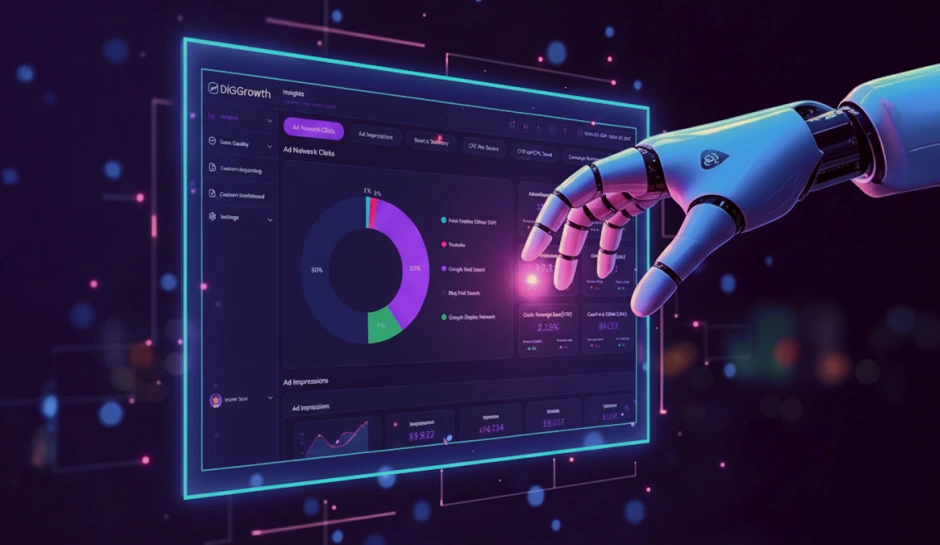
A Guide to Implementing the Ultimate KPI Dashboard for Businesses
Marketers can leverage KPI Dashboards to gain valuable insights into business performance. These dashboards offer a comprehensive view of key metrics, aiding in strategic decision-making. Marketers can drive success through informed actions by aligning KPIs with business objectives and using visualizations for clarity. Read on.
Key Performance Indicators (KPI) are not just numerical values but the compass that directs businesses toward success in a sea of data. These critical metrics provide an in-depth look at whether a company is achieving its strategic goals, which is why understanding and tracking the right KPI is essential for any robust business operation.
An effective KPI transcends basic number-crunching. It is inherently measurable, offering quantifiable evidence of progress or areas needing improvement. More importantly, it aligns seamlessly with strategic business objectives, bridging abstract goals and concrete actions.
From financial health to customer satisfaction, operational efficiency, and employee performance, KPIs encompass a spectrum of metrics that holistically capture a company’s performance. Each category is pivotal in sculpting a clear view of an organization’s trajectory.
By integrating these indicators into a centralized KPI dashboard, businesses empower themselves with the clarity of vision. Such a dashboard does not merely display data; it catalyzes informed decision-making, ultimately guiding companies through the labyrinth of business strategy toward the zenith of success.
Essentials of KPI Dashboard Design Principles
Understanding the essentials of dashboard design principles is pivotal to creating an effective KPI dashboard. An authoritative dashboard not only presents data but does so in a way that is intuitive and insightful for the user. Balancing aesthetics with functionality is the cornerstone of any dashboard’s success.
Balancing Aesthetics with Functionality
Your dashboard’s visual appeal is your first line of engagement with users. However, a well-designed dashboard must achieve more than just a pleasant look; it needs to provide a seamless and efficient experience. Functionality should never be compromised for the sake of visual design, and the most successful dashboards harmoniously blend the two, ensuring a tool that is pleasing to the eye and highly practical.
Understanding the User’s Journey for an Intuitive UI and Positive UX
A deep understanding of the user’s journey is vital to structuring an intuitive UI (User Interface) that contributes to a positive UX (User Experience). Users should be able to navigate the dashboard effortlessly to find the information they need without confusion or delay. This understanding leads to design choices that simplify the user’s interaction with the dashboard, enabling them to perform their tasks with greater efficiency and satisfaction.
Customizing Dashboards for Different Business Roles and Needs
Not all users have the same requirements. A one-size-fits-all approach doesn’t work when it comes to dashboards. Customization is key in ensuring the relevance of the data displayed for different business roles. Managers may need a high-level overview, while analysts might require more detailed data. Tailoring dashboards to meet these varying needs means more effective monitoring and decision-making across all levels of the organization.
Leveraging Business Intelligence (BI) for KPI Dashboards
Business Intelligence (BI) transforms data analytics by offering powerful tools, systems, and strategies for collecting, analyzing, and presenting data. Modern KPI dashboards, enriched by BI, provide interactive ways of viewing data, enabling businesses to quickly adapt to market changes.
BI tools distill vast data into precise KPIs, focusing on metrics that truly matter for measurable outcomes. Through KPI analysis, executives identify trends, successes, and areas needing action.
Integration with custom and personalized dashboard features empowers users with tailored insights:
- Customization:
- Personalization:
Focuses on relevant KPIs for specific roles or responsibilities.
Allows individual preferences to dictate the format and content, enhancing data comprehension.
The Power of Data Visualization in KPI Dashboard
Visual representation of data is not just about presenting numbers and stats—it’s about turning data into a comprehensive story that can be immediately understood. The beauty of data visualization in KPI dashboards lies in its ability to provide rapid insight acquisition. With intuitive graphs and charts, decision-makers can quickly grasp complex data sets and detect trends that might go unnoticed in traditional reports.
Choosing the Right Chart Types for Different Performance Indicators
- Every KPI has a unique story; selecting the right chart type is essential for effective storytelling.
- Line charts are ideal for showcasing trends over time and clearly visualizing how a particular metric has evolved.
- Bar charts excel in comparing the performance of different items or categories, making it easy to discern differences in performance at a glance.
- Pie charts are useful for illustrating proportions within a whole, allowing viewers to quickly grasp the distribution of a metric across various segments.
- Gauges visually represent a metric’s status relative to predefined thresholds, offering a quick assessment of whether performance meets expectations.
- The key to effective visualization is selecting a chart type that enhances understanding of your KPIs, ensuring that the message is conveyed clearly and accurately.
Techniques to Ensure Visualizations Convey the Correct Strategic Message
- Implement a logical flow that guides the viewer’s eye through the dashboard.
- Use color with purpose, to draw attention or illustrate relationships, not just to decorate.
- Limit the use of strong elements to emphasize key data points without overwhelming the viewer.
- Apply appropriate scales so that data comparisons are valid and useful.
Metric Selection and Prioritization for Maximum Impact
- Strategic Metric Selection:
- Prioritize Actionable Insights:
- Continuous Assessment:
- Dynamic Dashboard:
- Effective Utilization:
Carefully choose KPIs that directly contribute to achieving business goals, ensuring that each metric serves a specific purpose within the dashboard’s context.
Emphasize KPIs that provide actionable insights, allowing decision-makers to take concrete steps based on the data presented.
Implement a system for regularly reviewing and updating KPIs to align them with evolving business needs and priorities, ensuring that the dashboard remains relevant and effective over time.
Create a flexible dashboard that can adapt to changes in the business landscape by incorporating mechanisms for adding, removing, or adjusting metrics as necessary.
Utilize the dashboard as a strategic tool by focusing on KPIs that offer meaningful insights and drive positive outcomes, maximizing its value in guiding business decisions and actions.
Aligning Goals and Objectives through KPI Dashboard
A successful business strategy’s essence lies in aligning core goals and objectives with operational execution, and KPI Dashboards stand at the nexus of this alignment. By deploying SMART (Specific, Measurable, Achievable, Relevant, Time-bound) criteria in dashboard design, companies can set precise targets and monitor their progress with clarity and precision.
Techniques for Setting SMART Goals Reflected in Dashboard Design
- Understanding Goals:
- Incorporating SMART Goals:
- Intentional Metrics:
- Tracking Progress:
- Highlighting Path to Success:
Gain a clear understanding of what needs to be achieved before designing the dashboard.
Ensure each goal is Specific, Measurable, Achievable, Relevant, and Time-bound.
Align every metric within the dashboard with SMART goals to ensure their relevance and effectiveness.
Design a well-structured dashboard that tracks these metrics and provides visibility into progress toward each SMART goal.
Use the dashboard to highlight the path from current performance to desired outcomes, guiding decision-making and actions.
Ensuring that Dashboard Indicators are Aligned with Business Objectives
It is vital for KPIs reflected on the dashboard to resonate seamlessly with larger business objectives. When indicators align with the strategic goals, stakeholders can focus on driving performance where it counts. Aligning KPIs with business objectives transforms raw data into actionable insights, making the path to goal attainment clear.
Optimizing KPI Dashboard with Intuitive UI/UX Design
Understanding the intricate connection between User Interface (UI) and User Experience (UX) design principles and the effectiveness of KPI dashboards is pivotal for any business. Designing a dashboard that presents data effectively and enhances the user’s ability to interact with and understand this data is fundamental for informed decision-making.
Customization: Tailoring Dashboards to User Needs
Each user interacts with data differently. Customization features are key to enhancing the dashboard experience, allowing for a personalized view that caters to individual roles, responsibilities, and preferences within an organization. From adjustable layouts to selectable metrics, customization empowers users to create a dashboard environment that resonates with their unique analytical needs.
Incorporating User Feedback for Dashboard Refinement
User feedback is an invaluable asset in the ongoing process of dashboard design. Businesses can continuously refine their dashboards by incorporating suggestions and real-world usage insights. This improves their functionality and usability and ensures that they evolve in line with users’ expanding and changing requirements.
Data-driven Decision Making with KPI Dashboard
Data-driven decision making has become the cornerstone of successful business strategies. KPI dashboards serve as pivotal tools in this paradigm, transforming raw data into actionable business insights. By presenting data in an organized and easy-to-digest manner, these dashboards empower decision-makers to understand their organization’s performance at a glance and make informed choices quickly.
- Real-time Insights:
- Trend Analysis:
- Alignment with Goals:
- Performance Optimization:
- Collaborative Decision-Making:
Dashboards provide instant access to current data, enabling prompt decision-making based on the latest information.
Visualizing KPIs over time helps identify trends and patterns, empowers proactive strategies, and forecasts future outcomes.
KPIs are carefully selected to reflect strategic objectives, ensuring that every data point contributes to organizational success.
By pinpointing areas of underperformance or inefficiency, dashboards enable targeted interventions and continuous improvement efforts.
Dashboards are a common platform for data-driven discussions, fostering collaboration and alignment across teams and departments.
Best Practices for Building Effective KPI Dashboards
Creating insightful KPI dashboards involves more than just presenting data; it provides clarity, drives action, and adds value to the decision-making process. To ensure that your KPI dashboards serve their intended purpose efficiently, here are some best practices you should adhere to:
Strategic KPI Selection: Choose KPIs that directly align with organizational goals and strategic objectives, ensuring relevance and focus.
- Simplicity and Clarity:
- Contextual Insights:
- Real-time Data Updates:
- Customization Features:
- Regular Maintenance and Review:
Design the dashboard interface with simplicity in mind, using clear and intuitive visualizations to convey information effectively.
Provide contextual information alongside KPIs to help users understand the data’s significance and implications for decision-making.
Incorporate real-time or frequent data update mechanisms to ensure the dashboard reflects current information.
Offer customization options that allow users to tailor the dashboard to their specific needs and preferences, enhancing usability and relevance.
Establish a schedule for regular maintenance and review of the dashboard to address any changes in business priorities or data requirements, ensuring ongoing effectiveness and relevance.
Key Takeaways
- Thoroughly designed KPI dashboards offer critical business insights, as a compass for navigating data complexities.
- Ongoing refinement of KPI dashboards is essential for superior decision-making practices, ensuring adaptability to evolving business landscapes.
- Integration of KPI dashboards into strategic business analysis is crucial for sustainable growth and competitive advantage in the marketplace.
Conclusion
Effective KPI dashboards are not just tools; they are strategic assets that empower businesses to unlock their full potential. By embracing the power of data and continuously refining their KPI dashboards, business leaders can make informed decisions, anticipate future needs, and drive their organizations toward continued growth and success in an ever-changing business environment.
For further assistance implementing and refining your KPI dashboard Talk to Us!
We would love to meet you wherever you are in your setup of KPI Dashboard. Just write to us at info@diggrowth.com and we’ll get back to you.
Ready to get started?
Increase your marketing ROI by 30% with custom dashboards & reports that present a clear picture of marketing effectiveness
Start Free Trial
Experience Premium Marketing Analytics At Budget-Friendly Pricing.

Learn how you can accurately measure return on marketing investment.
Additional Resources
How Predictive AI Will Transform Paid Media Strategy in 2026
Paid media isn’t a channel game anymore, it’s...
Read full post postDon’t Let AI Break Your Brand: What Every CMO Should Know
AI isn’t just another marketing tool. It’s changing...
Read full post postFrom Demos to Deployment: Why MCP Is the Foundation of Agentic AI
A quiet revolution is unfolding in AI. And...
Read full post postFAQ's
Data security is paramount when dealing with sensitive business information. Ensure that your KPI dashboard implementation includes robust security measures such as encryption, access controls, and regular audits to safeguard data integrity and confidentiality.
The effectiveness of your KPI dashboard can be measured by its ability to provide actionable insights, drive informed decision-making, and contribute to overall business success. You can also gather user feedback to identify improvement and refinement areas.
Scalability is crucial to accommodate increasing data volumes and changing business needs. Design your KPI dashboard architecture with scalability in mind, leveraging scalable technologies and flexible data storage solutions. Regularly assess and optimize performance to ensure the dashboard remains responsive and efficient as your business expands.


